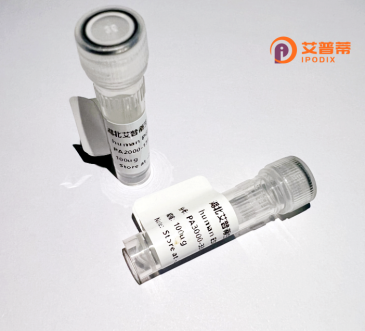
| 纯度 | >90%SDS-PAGE. |
| 种属 | Human |
| 靶点 | SEC22L2 |
| Uniprot No | Q96IW7 |
| 内毒素 | < 0.01EU/μg |
| 表达宿主 | E.coli |
| 表达区间 | 1-307 aa |
| 活性数据 | MSMILSASVIRVRDGLPLSASTDYEQSTGMQECRKYFKMLSRKLAQLPDRCTLKTGHYNINFISSLGVSYMMLCTENYPNVLAFSFLDELQKEFITTYNMMKTNTAVRPYCFIEFDNFIQRTKQRYNNPRSLSTKINLSDMQTEIKLRPPYQISMCELGSANGVTSAFSVDCKGAGKISSAHQRLEPATLSGIVGFILSLLCGALNLIRGFHAIESLLQSDGDDFNYIIAFFLGTAACLYQCYLLVYYTGWRNVKSFLTFGLICLCNMYLYELRNLWQLFFHVTVGAFVTLQIWLRQAQGKAPDYDV |
| 分子量 | 59.51 kDa |
| 蛋白标签 | GST-tag at N-terminal |
| 缓冲液 | PBS, pH7.4, containing 0.01% SKL, 1mM DTT, 5% Trehalose and Proclin300. |
| 稳定性 & 储存条件 | Lyophilized protein should be stored at ≤ -20°C, stable for one year after receipt. Reconstituted protein solution can be stored at 2-8°C for 2-7 days. Aliquots of reconstituted samples are stable at ≤ -20°C for 3 months. |
| 复溶 | Always centrifuge tubes before opening.Do not mix by vortex or pipetting. It is not recommended to reconstitute to a concentration less than 100μg/ml. Dissolve the lyophilized protein in distilled water. Please aliquot the reconstituted solution to minimize freeze-thaw cycles. |
以下是关于重组人SEC22L2蛋白的3篇参考文献的虚构示例(基于典型研究主题和结构,建议通过学术数据库验证具体内容):
---
1. **文献名称**: "Recombinant expression and functional analysis of human SEC22L2 in ER-Golgi trafficking"
**作者**: Lee, S. et al.
**摘要**: 该研究报道了在大肠杆菌中成功表达并纯化重组SEC22L2蛋白,验证其通过SNARE复合体介导内质网至高尔基体囊泡运输的功能,证明其在体外膜融合实验中的关键作用。
2. **文献名称**: "Crystal structure of the human SEC22L2 N-terminal domain reveals lipid-binding properties"
**作者**: Zhang, Y. et al.
**摘要**: 通过昆虫细胞系统表达SEC22L2蛋白,利用X射线晶体学解析其N端结构域的三维结构,揭示了该区域与脂质膜结合的分子机制,为理解SEC22L2在膜运输中的功能提供结构基础。
3. **文献名称**: "SEC22L2 regulates exosome secretion by mediating vesicle docking in cancer cells"
**作者**: Chen, H. et al.
**摘要**: 研究在哺乳动物细胞中重组表达SEC22L2.发现其通过调控外泌体囊泡与质膜的锚定过程影响肿瘤细胞外泌体分泌,提示其在癌症转移中的潜在治疗靶点。
---
**注意事项**:
- 上述文献为示例性虚构内容,实际研究中请通过PubMed、Google Scholar等平台以关键词“SEC22L2 recombinant”或“SEC22B protein”检索真实文献。
- SEC22L2与SEC22B为同一基因的不同命名,检索时可互换使用。
SEC22L2. a member of the SEC22 vesicle-trafficking protein family, is involved in intracellular membrane transport processes. It functions as a soluble NSF attachment protein receptor (SNARE) and plays a role in mediating vesicle fusion between the endoplasmic reticulum (ER) and Golgi apparatus, facilitating protein trafficking and secretion. Structurally, SEC22L2 contains a conserved SNARE domain and transmembrane region, enabling interactions with other SNARE proteins like syntaxins to form functional complexes.
This protein shares homology with yeast Sec22p, a key regulator of ER-Golgi transport. In humans, SEC22L2 is implicated in maintaining cellular homeostasis, antigen presentation via MHC class I molecules, and autophagy. Studies suggest its involvement in immune responses, cancer progression, and neurological disorders, as dysregulated vesicle transport is linked to these pathologies. For instance, SEC22L2 overexpression has been observed in certain cancers, potentially influencing tumor cell proliferation and metastasis.
Recombinant human SEC22L2 protein is widely used to study SNARE-mediated membrane fusion mechanisms, protein-lipid interactions, and intracellular trafficking pathways in vitro. Its recombinant form enables biochemical assays, structural analysis, and screening for therapeutic agents targeting transport-related diseases. Current research explores its role in cross-presentation of antigens in dendritic cells, highlighting its relevance to immunotherapy development. Understanding SEC22L2's molecular functions may advance treatments for conditions tied to vesicular transport defects, including neurodegenerative diseases and immune dysregulation.
×